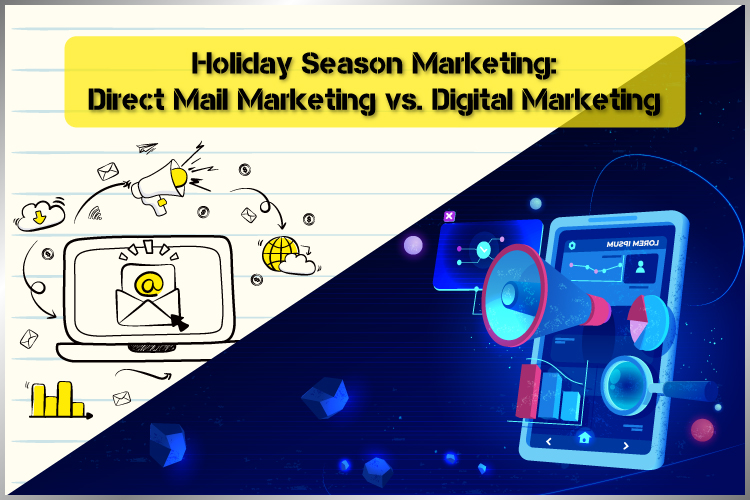Holiday Season Marketing: Direct Mail Marketing vs. Digital Marketing

Holidays are the season of joy, celebration, and gatherings where people send their love to each other in the form of gifts and surprises. And it’s almost that time of the year again. More and more people are willing to spend a great deal of money for their near and dear ones. Holidays highly influence retail and seasonal shopping is something that retailers can safely count on even today.
If you run a business, whether it is a shoe store or a clothing brand, you must participate in this trend. The best way to leverage this festive season and elevate your brand is to have a solid marketing strategy in place that incorporates direct mail marketing or digital marketing – either one of them.
This blog will talk about the points that will help you decide which one is ideal for your strategy this holiday season. Let’s take a look at Direct Mail Marketing vs. Digital Marketing.
Cost-Effectiveness
Although you need to put in more effort and time in direct mail marketing, even after considering the standard courier rates and the total cost that goes into the things used to prepare mails, it turns out that direct mail marketing is comparatively cheaper than digital marketing. The reason being that the majority of the websites will charge the advertisers a fixed amount to display their ads, which can be both costly and doubtful since we don’t know about its effectiveness.
On the other hand, with direct mail marketing, advertisers can choose to send out a small shipment first for testing, which will help you save more money and give you the opportunity to make improvements if required. This way, whenever you have to send direct mails, you can decide how much you want to spend, depending on your reach rather than being compelled to pay a fixed price. This also allows you to upgrade your choices once you see the initial results and customer response to your mail.
Response Rate
Direct mail marketing takes a more targeted approach, and therefore, it also receives a much higher response rate as compared to digital marketing. This isn’t a mere assumption; the statement is backed by multiple studies. The reason behind this is an average person sees around 4000-5000 online ads and receives more than 120 marketing emails per day, causing your ads to get lost in the ocean.
ROI
Direct mail marketing is a more preferred marketing strategy over digital marketing because it renders a more solid return on investment. The reason is that the majority of businesses are emphasizing establishing their brand online, reducing the competition in direct mails, and making it a more dependable sector. Moreover, direct mail marketing has a better ROI since customers are most often likely to prefer direct mails over digital content. Because at the end of the day, online ads are not as engaging as receiving personalized mails at the doorstep.
Flexibility
When it comes to marketing options, direct mails are more flexible. In digital marketing, businesses can only pick one website where they want to promote their brands or how they would like to send their ads to their customers. On the other hand, with direct mail marketing, advertisers get plenty of options to choose from, extending from tiny business cards to small gifts, brochures, postcards, letters, and much more.
Personal Touch
The majority of the customers admitted that receiving direct mail makes them feel special and more valued. This is because advertisers can personalize the direct mails to suit the potential customer’s interests while online ads are typically generic, which makes it less likely for the users to engage with it actively.
Conclusion
Even though people have nicknamed direct mail marketing as an “old hat,” it is a touchpoint that you must apply to your marketing efforts and sales strategy to achieve the best results. But remember that at last, a good marketing strategy is not about weighing up direct mail marketing and digital marketing; instead, it is about integrating multiple marketing channels and offering an omnichannel customer experience to your target audience this festive season. So, keep these points in mind and determine which strategy better suits your budget, audience, resources, etc. and start working on it.
